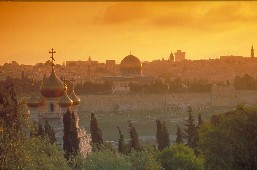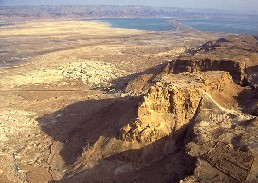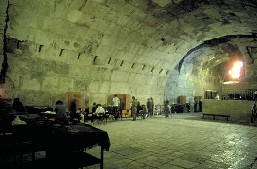

Menu |
Footsteps of Paul
Israel
Seven Churches Cruise Retreats
________________
Blog
Photo
Gallery
Individual Travelers
Where Do I Begin
Travel Ministry
FAQ
TravelSafe
Insurance
Helpful Links
What
others say
Contact Us







Israel Demographics & History
Capital: Jerusalem
Population (2004 est.): 6,276,883
Religions: Judaism 82%, Islam 14%, Christian 2%
Language: Israel’s official languages are Hebrew and Arabic. English is the main language for purposes of external relations. Most Israelis speak English, and most of the signposts are also in English.
Location: Israel is bordered by the Mediterranean in the west, the Great Syrian-African Rift in the east and the Red Sea in the south. Israel's immediate neighbors are Lebanon, Jordan, Syria, and Egypt. Israel is a small country.
Israeli flag:

Geography:Israel is located in Southwest Asia between the Mediterranean and the deserts of Syria and Arabia. The country's geographical borders are the Mediterranean to the West, the Jordan Valley Rift to the East, the mountains of Lebanon to the North with Eilat Bay marking the country's southern tip. Although small in territory, Israel's landscape and climate are varied, and its dense population does not interfere with a wealth of plants and wildlife, as well as many natural attractions.
Agricultural Products: Citrus and other fruits, vegetables, cotton, beef, poultry, dairy products Major Industries: Food processing, diamond cutting and polishing, textiles and apparel, metals
Time Zone: Israeli time is seven hours ahead of Eastern Time. When it is 12 noon in New York, it is 7 pm in Jerusalem.
National Holidays:
December 25: Christmas Day
December-January: Hanukkah
January: Epiphany
January 7: Orthodox Christmas Day
January 19: Armenian Christmas Day
January-February: 15th of Shevat
February-March: Purim
March: Annunciation
March-April-May: Pesah, Mimouna, Easter, Holocaust Day
April 24: Armenian Holocaust Day
April-May: Independence Day
May: Lag B’Omer, Ascension, Pentecost
May-June: Shavuot
What is the currency? In Israel, the currency is the Shekel. One US dollar is worth approximately 5 shekels(this will vary)
ATMs: Most banks have ATMs and are open every day except Saturday.
Tipping: When tipping, pay cash, not credit. In restaurants tip 12-15%, however some automatically include a 12.5% service charge.
What items should I shop for in Israel? Israel is famous for its exclusive lines of bathing suits (Gottex, Gideon Oberson), skin-care products made from mineral-rich Dead Sea mud, glass, art, leather coats, silver jewelry, diamonds, painted tiles, embroidery, religious items & antiques.
What are the voltage requirements in Israel? Voltage: 230 V; Plugs H & C. You will need a voltage converter, and plug adapter in order to use U.S. appliances. We recommend getting a universal adapter and converter kit.
Settlement and Conquest in Biblical Times: The Canaanite tribes were the first settlers in Israel and its principal inhabitants till the second millennium BCE. In this early time the country was already a meeting place of different cultures: Egypt to the south, Assyria Mesopotamia and Asia Minor to the north. During the second millennium BCE several tribes started an invasion of the country, including the Philistines who came from the Aegean and settled in the southern coastal plain, and the Hebrews who came from Mesopotamia and settled in the hills.
The Hebrews, known as
the Sons of Israel lived in the framework of 12 tribes who were united towards
the end of the second millennium BCE by the first King of Israel, Saul. His
successor, David, expanded the borders of the country and made Jerusalem,
till then a Jebusite city, into his capital. It was here that his son King
Solomon built the Temple with the Holy Ark. After Solomon’s death the
kingdom was divided into two, with the ten northern Tribes setting up the
Kingdom of Israel while the remaining two tribes set up the Kingdom of Judah
in the Jerusalem Hills. In the year 721 BCE, the Kingdom of Israel was conquered
by the Assyrians; the 10 tribes were sent into exile and are considered “lost”
till this day. The kingdom of Judah was conquered by the Babylonians in the
year 586 BCE, the Temple was destroyed and the Sons of Israel went into the
first Babylonian exile.
Between Empires – From the Babylonians to the Byzantines:
In the year 539 BCE, Babylon was conquered by the Persians and the tribe of
Judah was allowed to return to Jerusalem, which was part of the Persian Empire.
Jerusalem was erected from the rubble and the Second Temple was built. In
the year 333 BCE, the Persian Empire, with the Land of Israel, was conquered
by Alexander the Great, and in the year 66 BCE it was conquered by the Roman
general Pompey. For the next 200 years the country was ruled by Jewish kings
as a Roman vassal state. These were troubled times. In the year 70 CE the
Temple was destroyed after a Jewish rebellion and in the year 135 BCE the
Jews were sent into exile after another rebellion. Jerusalem was destroyed
to its foundations and a Roman city was set up in its place.
Jesus Christ was born when the country was under Roman rule, but it took 300 years until Christianity was legitimized in the Roman Empire which in turn became Byzantium in the east.
As Christianity was legitimized and became the official religion the view of the Land of Israel as the Holy Land developed. It became a destination for pilgrims and a huge building enterprise got under way with churches and monasteries built all over the country. It was at this time that parts of the Church of the Holy Sepulcher in Jerusalem and the Church of Nativity in Bethlehem were built. Remnants of the building from this era can be seen at Ovdat, Capernaum (Kfar Nakhum,) Khamat Gader and Latroun.
The State of Israel: In the year 1948, the British Mandate came to an end and the state of Israel was created. It founders said in the Declaration of Independence: “The State of Israel will be open to the immigration of Jews and for the Ingathering of the Exiles from all countries of their dispersion; will promote the development of the country for the benefit of all its inhabitants; will be based on the precepts of liberty, justice and peace… will guarantee full freedom of conscience, worship, education and culture; will safeguard the sanctity and inviolability of the shrines and Holy Places of all religions...”
The State of Israel, set up at the meeting places of continents, history and cultures embodies this rich web of cultures. Its population includes different peoples and religions, religious and secular, Arab Moslems and Arab Christians, Druze, Bedouins, Circassians, Samaritans and Jews from 70 Diasporas, from East and Western Europe, North Africa, Asia, North and South America. The people are settled all over the country in the Negev, Arava, Galilee and coastal plain, in moshavim, kibbutzim, vivacious cities and quiet villages busily engaged in industry and commerce, farming and scientific research. All of these cultures, peoples and religions created a rich tapestry of tradition, beliefs and customs that encapsulate the holy and the secular, the past and the present, the east and the west.
Source: Israel Ministry of Tourism